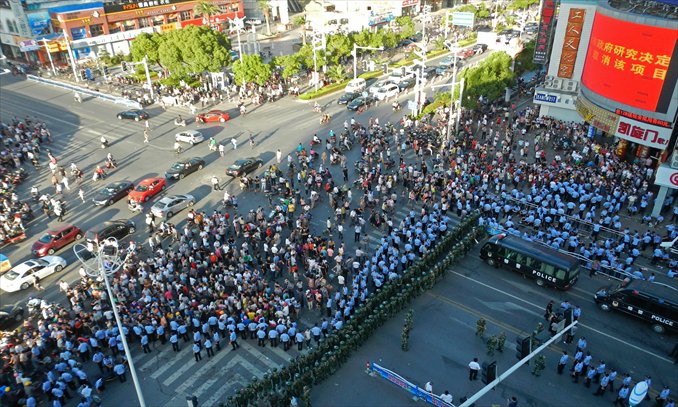Mechanism needed to avoid violent protests

Less than a month since protests in Shifang halted a heavy metal refinery project, a similar incident occurred in Qidong, Jiangsu Province, Saturday. A massive protest was staged in front of the city hall against a pollution discharge plant. Demonstrators smashed government offices and stripped the clothes off a local official. The local government immediately announced it was canceling the project permanently.
The Qidong protest may have been inspired and encouraged by the Shifang incident. They both achieved the same result through extreme approaches. The quick compromise made by the Qidong government may also have been learnt from Shifang.
The two protests have together left the impression that the fastest way to change a government policy is to hold a violent demonstration. If this model is copied widely, it would be disastrous for social stability. It encourages the public to resort to radical methods to realize its demands.
This model must be broken. Policies concerning broad public interests cannot be decided only by officials. Public participation needs to be implemented, and not just as a show. Once decisions made through this process are met with mass protests, they cannot be immediately canceled by officials either. They should be able to resist the challenge. Whimsical decisions on a large project will only send the public a wrong message.
The two incidents have shown the public's deep fear of environmental pollution. Once stimulated, it may lead to a disruptive reaction. In the future, major projects with an environmental impact will all face a fragile social psychology. It's not only social stability, but also future economic growth that will be challenged.
Improper decision-making has weakened two local governments' ability to respond to the ensuing mass incidents. Projects involving hundreds of millions of yuan in investment were halted immediately. Violent demonstrators were not held accountable according to the law. The two incidents are a very bad example to the country.
The blame should not be shouldered solely by the two local governments. There is no clear policy or regulation on dealing with mass incidents. Choking under the pressure of public opinion and the tough task of maintaining social order before the coming Party congress proved too much for two small city governments. Their desperate reactions were intuitive.
Without a mechanism to deal with mass incidents, government reactions nationwide have been quite random. Compromise seems to be the most likely decision of local governments in the face of massive protests. At least public opinion perceives this to be the case.
Related report:
Order restored to Qidong after protest
Order was basically restored Sunday on the streets near the government office of Qidong, where thousands of residents gathered and stormed the compound the previous day in protest at a planned pipeline that will channel waste water into the sea for a Japanese paper factory.